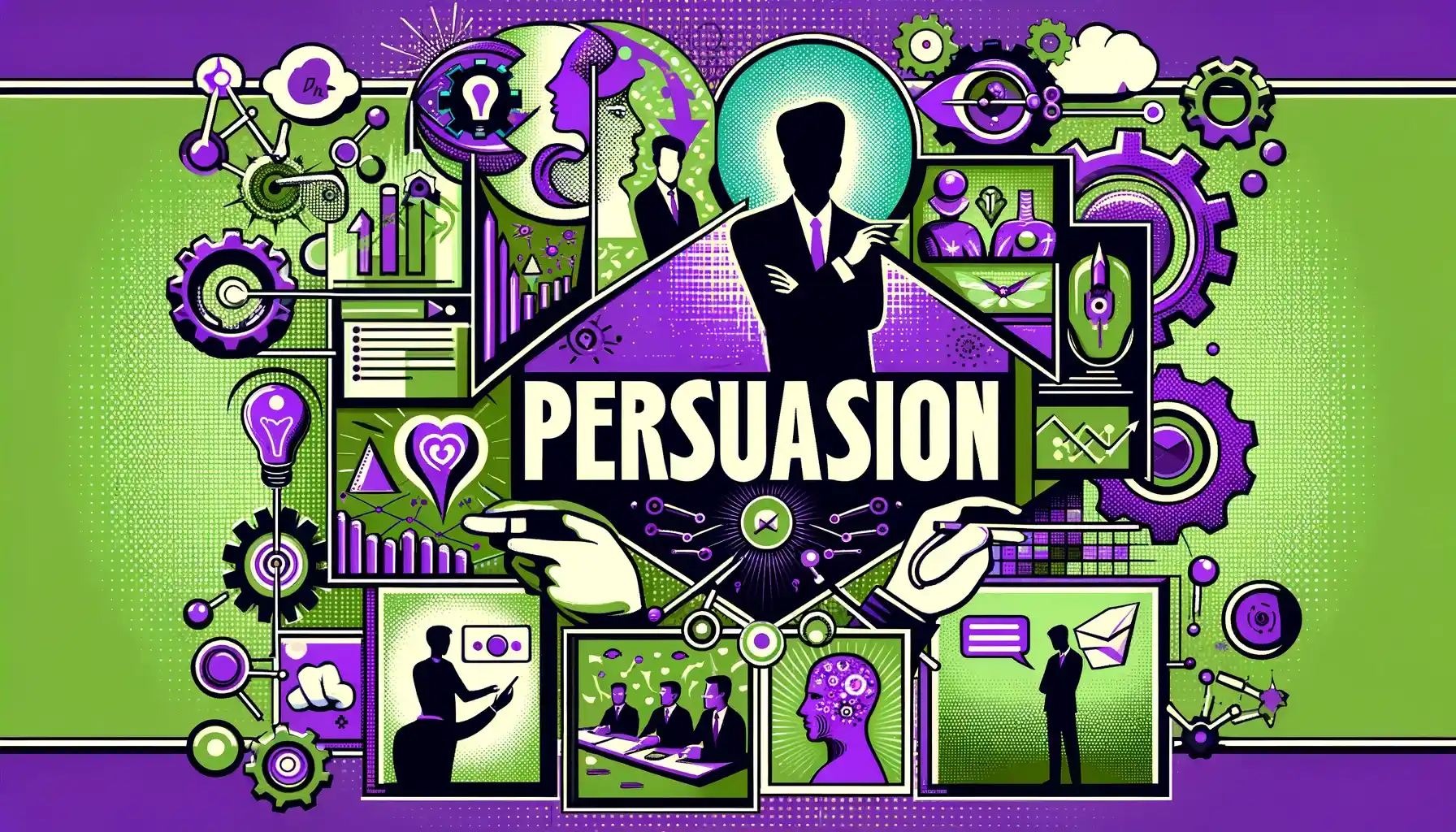Introduction
<p><span style="font-weight: 400;">When I was around ten years old, I dreamed of becoming a magician. My wife says that being a game designer isn’t too far from that dream, but what fascinated me most about magic was the idea of hypnotizing people. You see, I was a chubby boy, and people around me didn’t buy me sweets. I wanted to persuade them otherwise. Maybe you had a similar experience, yearning to influence others for your purposes. Persuasion, in many ways, is the magic of our childhood dreams, and some of us have learned to wield it better in our lives. According to WiseWorld.ai, persuasion falls under the Communication subcategory of soft skills.</span></p>
<h3><strong>Definition of Persuasion</strong></h3>
<p><span style="font-weight: 400;">Persuasion is the act of convincing others to believe something, agree to a proposal, or take action. It involves using arguments, reasoning, or appeals to emotions to influence someone's thoughts or behaviors.</span></p>
<h3><strong>Negotiation vs. Persuasion</strong></h3>
<p><span style="font-weight: 400;"><a class='no-underline text-accent' href="wiseworld.ai/blog/negotiation" target="_blank">Negotiation</a> and persuasion are critical components of effective communication, yet they serve different purposes and contexts.</span></p>
<p><strong>Negotiation</strong><span style="font-weight: 400;"> is a collaborative process aimed at reaching a mutually beneficial agreement. It involves bargaining, compromising, and problem-solving to meet the interests of all parties. For example, during salary negotiations, both the employer and the employee discuss terms until they reach a satisfactory agreement.</span></p>
<p><strong>Persuasion</strong><span style="font-weight: 400;">, however, focuses on influencing others to accept your ideas or take specific actions. It relies on building strong arguments, and emotional connections, and creating enthusiasm for your proposals. For instance, a marketer persuading potential customers to buy a product uses compelling stories and evidence to highlight the product's benefits.</span></p>
<p><strong>Key Differences</strong><span style="font-weight: 400;">:</span></p>
<ul>
<li style="font-weight: 400;" aria-level="1"><strong>Objective</strong><span style="font-weight: 400;">:</span></li>
<ul>
<li style="font-weight: 400;" aria-level="2"><strong>Negotiation</strong><span style="font-weight: 400;">: Achieve mutual agreement.</span></li>
<li style="font-weight: 400;" aria-level="2"><strong>Persuasion</strong><span style="font-weight: 400;">: Convince others to accept your viewpoint or act.</span></li>
</ul>
<li style="font-weight: 400;" aria-level="1"><strong>Approach</strong><span style="font-weight: 400;">:</span></li>
<ul>
<li style="font-weight: 400;" aria-level="2"><strong>Negotiation</strong><span style="font-weight: 400;">: Involves compromise and finding common ground.</span></li>
<li style="font-weight: 400;" aria-level="2"><strong>Persuasion</strong><span style="font-weight: 400;">: Uses logical arguments, emotional appeals, and credibility.</span></li>
</ul>
<li style="font-weight: 400;" aria-level="1"><strong>Application</strong><span style="font-weight: 400;">:</span></li>
<ul>
<li style="font-weight: 400;" aria-level="2"><strong>Negotiation</strong><span style="font-weight: 400;">: Used in formal agreements, conflict resolution, and business deals.</span></li>
<li style="font-weight: 400;" aria-level="2"><strong>Persuasion</strong><span style="font-weight: 400;">: Applied in marketing, leadership, and everyday interactions.</span></li>
</ul>
</ul>
<p><span style="font-weight: 400;">Understanding the differences between negotiation and persuasion can enhance your ability to navigate various situations effectively, whether it's reaching an agreement or convincing someone to support your ideas. Both skills are essential for achieving personal and professional success and are key components of a strong work ethic.</span></p>
<h3><strong>Importance in Real Life</strong></h3>
<p><span style="font-weight: 400;">Persuasion is an indispensable skill in various aspects of life. From convincing your boss to give you a raise to getting your kids to eat their vegetables, the ability to persuade others can have a significant impact on your personal and professional success.</span></p>
<p><span style="font-weight: 400;">Imagine trying to convince a friend to join you on a spontaneous trip. Your ability to paint a vivid picture of the adventure, highlight the excitement, and downplay the inconveniences can make all the difference. Similarly, in the workplace, persuading your team to adopt a new strategy requires a blend of logic, empathy, and compelling storytelling.</span></p>
Benefits of Persuasion
<p><span style="font-weight: 400;">Persuasion isn’t just about getting what you want; it’s about creating win-win situations and building relationships. Here are some key benefits:</span></p>
<h4><strong>Enhanced Communication</strong></h4>
<p><span style="font-weight: 400;">Being persuasive improves your ability to communicate effectively. It helps you articulate your ideas clearly and compellingly, making it easier for others to understand and agree with your point of view.</span></p>
<p><span style="font-weight: 400;">Consider the art of storytelling. When Steve Jobs introduced the iPhone, he didn't just list features. He told a story about a revolutionary device that would change the world. This narrative made the concept tangible and exciting, persuading millions to buy into his vision.</span></p>
<h4><strong>Career Advancement</strong></h4>
<p><span style="font-weight: 400;">Strong persuasion skills can lead to career advancement. Whether you’re negotiating a promotion, pitching a project, or leading a team, the ability to persuade others can position you as a leader and influencer in your organization.</span></p>
<p><span style="font-weight: 400;">For instance, </span><a class='no-underline text-accent' href="https://en.wikipedia.org/wiki/Sheryl_Sandberg"><span style="font-weight: 400;">Sheryl Sandberg</span></a><span style="font-weight: 400;"> (an American technology executive, philanthropist, and writer) negotiated her compensation at Facebook by persuasively articulating her values and expectations. Her ability to present a compelling case not only secured her a favorable deal but also set a precedent for executive compensation negotiations.</span></p>
<h4><strong>Conflict Resolution</strong></h4>
<p><span style="font-weight: 400;">Persuasion is a critical tool in conflict resolution. It enables you to mediate disputes and find common ground, fostering a collaborative environment.</span></p>
<p><span style="font-weight: 400;">Think of Nelson Mandela's negotiations to end apartheid in South Africa. His persuasive approach, emphasizing reconciliation and mutual understanding, was instrumental in achieving a peaceful transition and lasting change.</span></p>
<h4><strong>Influence and Leadership</strong></h4>
<p><span style="font-weight: 400;">Effective leaders are often persuasive communicators. They inspire and motivate others to follow their vision and work towards common goals.</span></p>
<p><span style="font-weight: 400;">Steve Jobs, known for his exceptional persuasion skills, convinced top talent to join Apple and investors to believe in his vision, demonstrating the power of persuasive leadership. His ability to sell a dream turned Apple into one of the most valuable companies in the world.</span></p>
<h3><strong>Importance of Persuasion</strong></h3>
<p><span style="font-weight: 400;">The ability to persuade is vital for achieving goals, building relationships, and navigating challenges. Here’s why:</span></p>
<h4><strong>Achieving Goals</strong></h4>
<p><span style="font-weight: 400;">Persuasion helps you achieve personal and professional goals. Whether negotiating a salary increase, securing a business deal, or convincing a friend to join you on a trip, effective persuasion ensures you get what you want.</span></p>
<h4><strong>Building Relationships</strong></h4>
<p><span style="font-weight: 400;">Persuasion builds trust and respect, which are foundational for strong relationships. By finding mutually beneficial solutions, you strengthen partnerships and foster future collaborations.</span></p>
<p><span style="font-weight: 400;">Consider the phrase, "You catch more flies with honey than with vinegar." This adage underscores the importance of kindness and understanding in persuasion. Building relationships through positive interactions makes people more likely to support your goals.</span></p>
<h4><strong>Navigating Challenges</strong></h4>
<p><span style="font-weight: 400;">Persuasion skills enable you to navigate challenges effectively, finding solutions that satisfy all parties involved. For instance, in high-stakes business negotiations, being persuasive can lead to agreements that benefit both your company and the other party. Consider a scenario where you're trying to close a deal with a difficult client; your ability to understand their concerns and present compelling solutions can turn the tide in your favor.</span></p>Developing Persuasion Skills
<p><span style="font-weight: 400;">Persuasion is not an innate talent; it’s a skill that can be honed and refined with practice. Developing your persuasion skills can significantly enhance your ability to influence others and achieve your goals. Here are some techniques and strategies to help you become more persuasive.</span></p>
<h4><strong>Techniques to Cultivate Persuasion Skills</strong></h4>
<p><strong>Understand Your Audience</strong><span style="font-weight: 400;">: </span><span style="font-weight: 400;">Tailor your message to the interests and concerns of the person or group you are trying to persuade. This requires empathy and the ability to put yourself in their shoes. For example, if you’re persuading a team to adopt a new project management tool, emphasize how it will make their work easier and more efficient, addressing any concerns they might have about the transition.</span></p>
<p><strong>Build a Strong Argument</strong><span style="font-weight: 400;">: </span><span style="font-weight: 400;">Use logic, evidence, and well-structured arguments to make your case. This includes presenting facts, statistics, and examples that support your point of view. Think of a lawyer presenting a case in court—they must build a strong, evidence-based argument to persuade the jury.</span></p>
<p><strong>Appeal to Emotions</strong><span style="font-weight: 400;">: </span><span style="font-weight: 400;">While logic is important, emotions play a crucial role in persuasion. Connect with your audience on an emotional level by sharing stories, anecdotes, or examples that resonate with them. For instance, charity organizations often use emotional appeals in their campaigns by sharing stories of individuals who have benefited from their work.</span></p>
<p><strong>Establish Credibility</strong><span style="font-weight: 400;">:</span><span style="font-weight: 400;"> People are more likely to be persuaded by someone they trust and respect. Establish your credibility by demonstrating expertise, reliability, and honesty. This can be achieved by sharing your qualifications, experience, and track record of success. A professor persuading students to take their course, for example, might highlight their extensive research and publications in the field.</span></p>
<p><strong>Use Social Proof</strong><span style="font-weight: 400;">:</span><span style="font-weight: 400;"> People tend to follow the actions of others, especially those they admire or consider peers. Use testimonials, endorsements, and examples of others who have adopted your viewpoint or product successfully. For example, a marketer might use customer reviews and testimonials to persuade potential buyers to choose their product.</span></p>
<p><strong>Practice Active Listening</strong><span style="font-weight: 400;">: </span><span style="font-weight: 400;">Show that you value the other person’s perspective by listening actively. This builds rapport and makes them more receptive to your arguments. For instance, in a negotiation, acknowledging the other party’s concerns and responding thoughtfully can make them more open to your proposals.</span></p>
<h4><strong>Learning to Embrace Empathy</strong></h4>
<p><span style="font-weight: 400;">Empathy is a cornerstone of effective persuasion. By understanding and addressing the needs and emotions of others, you can create a stronger connection and make your arguments more compelling. Empathy allows you to see the situation from the other person's perspective and tailor your approach accordingly. A manager trying to persuade their team to work overtime might empathize with their need for work-life balance and offer flexible scheduling as a compromise.</span></p>
<h4><strong>Practicing Mindfulness</strong></h4>
<p><span style="font-weight: 400;">Mindfulness can enhance your ability to stay present and focused during conversations, making you a more effective persuader. Mindfulness exercises, such as meditation, can improve your concentration and emotional regulation, allowing you to respond thoughtfully rather than react impulsively. Steve Jobs, known for his persuasive abilities, practiced Zen meditation to stay focused and calm, which contributed to his effective communication style.</span></p>
<h4><strong>Building Positive Habits</strong></h4>
<p><span style="font-weight: 400;">Developing positive habits around persuasion involves regular practice and reflection. Engage in activities that challenge your persuasive skills, such as debates, public speaking, and negotiations. Reflect on your experiences, analyze what worked and what didn’t, and seek feedback from others. Over time, these habits will strengthen your persuasion abilities and make you more confident in your interactions.</span></p>
<h3><strong>The Power of Empathy in Persuasion</strong></h3>
<p><span style="font-weight: 400;">A compelling example of empathy in persuasion is Mahatma Gandhi’s leadership during India’s struggle for independence. Gandhi’s ability to understand and connect with the masses was instrumental in persuading millions to join the nonviolent resistance against British rule. He empathized with the plight of ordinary Indians, using their language, symbols, and concerns to inspire a collective movement for freedom. His empathetic approach not only mobilized a nation but also demonstrated the profound impact of understanding and addressing the emotions and needs of others.</span></p>
<h3><strong>Mindfulness in Persuasive Negotiation</strong></h3>
<p><span style="font-weight: 400;">In high-stress business negotiations, maintaining composure and clarity is crucial. Consider Jeff Bezos during Amazon's early years. Bezos negotiated deals with major book publishers to expand Amazon's inventory. By staying calm, focused, and considerate of the publishers' perspectives and concerns, Bezos successfully secured favorable terms that helped Amazon grow into the e-commerce giant it is today. His mindfulness in handling negotiations and his ability to listen and address the needs of others were key factors in these successful deals.</span></p>
<p><span style="font-weight: 400;">By developing these techniques and embracing empathy and mindfulness, you can significantly enhance your persuasion skills. This not only helps in achieving your goals but also in building stronger, more positive relationships in both personal and professional contexts. Remember, persuasion is as much about listening and understanding as it is about speaking and convincing.</span></p>Training to Improve Negotiation
<p><span style="font-weight: 400;">Negotiation is a simple concept: a dialogue between two or more people, each to achieve. However, because it involves humans, each with unique attitudes and motivations, there is no golden rule for it. Effective negotiation requires continuous learning and practice.</span></p>
<h4><strong>Roleplay Game: "Snake Oil Persuasion Challenge"</strong></h4>
<p><strong>Objective:</strong><span style="font-weight: 400;"> To train participants in persuasion skills, emphasizing creativity, mind reading, and game theory through a fun scenario.</span></p>
<p><strong>Participants:</strong><span style="font-weight: 400;"> 4-10 players</span></p>
<p><strong>Materials Needed:</strong></p>
<ul>
<li style="font-weight: 400;" aria-level="1"><span style="font-weight: 400;">Index cards or paper</span></li>
<li style="font-weight: 400;" aria-level="1"><span style="font-weight: 400;">Pens</span></li>
<li style="font-weight: 400;" aria-level="1"><span style="font-weight: 400;">Timer</span></li>
<li style="font-weight: 400;" aria-level="1"><span style="font-weight: 400;">Hat or bowl for drawing scenarios</span></li>
</ul>
<p><strong>Setup:</strong></p>
<ul>
<li style="font-weight: 400;" aria-level="1"><span style="font-weight: 400;">Create index cards with fictional products (e.g., "Time-Traveling Device," "Invisible Cloak").</span></li>
<li style="font-weight: 400;" aria-level="1"><span style="font-weight: 400;">Create cards with buyer personas (e.g., "Skeptical Scientist," "Impressionable Teenager").</span></li>
<li style="font-weight: 400;" aria-level="1"><span style="font-weight: 400;">Place cards in a hat or bowl.</span></li>
</ul>
<p><strong>Gameplay Instructions:</strong></p>
<p><strong>Round 1: Scenario Setup</strong></p>
<ul>
<li style="font-weight: 400;" aria-level="1"><span style="font-weight: 400;">Each participant draws one product card and one buyer persona card.</span></li>
<li style="font-weight: 400;" aria-level="1"><span style="font-weight: 400;">Participants have 2 minutes to prepare their persuasive pitch.</span></li>
</ul>
<p><strong>Round 2: Persuasion Attempt</strong></p>
<ul>
<li style="font-weight: 400;" aria-level="1"><span style="font-weight: 400;">Each participant takes turns as the Seller, pitching their product to the group acting as Buyers with the personas they drew.</span></li>
<li style="font-weight: 400;" aria-level="1"><span style="font-weight: 400;">Sellers have 2 minutes to pitch, addressing Buyers' questions and objections.</span></li>
</ul>
<p><strong>Key Persuasion Techniques:</strong></p>
<ul>
<li style="font-weight: 400;" aria-level="1"><strong>Emotional Appeal:</strong><span style="font-weight: 400;"> Connect with Buyers' feelings.</span></li>
<li style="font-weight: 400;" aria-level="1"><strong>Logical Argument:</strong><span style="font-weight: 400;"> Provide clear, logical reasons.</span></li>
<li style="font-weight: 400;" aria-level="1"><strong>Scarcity:</strong><span style="font-weight: 400;"> Create urgency with limited availability.</span></li>
<li style="font-weight: 400;" aria-level="1"><strong>Social Proof:</strong><span style="font-weight: 400;"> Mention others' benefits from the product.</span></li>
<li style="font-weight: 400;" aria-level="1"><strong>Reciprocity:</strong><span style="font-weight: 400;"> Offer something in return for interest.</span></li>
</ul>
<p><strong>Example Scenario:</strong></p>
<ul>
<li style="font-weight: 400;" aria-level="1"><strong>Product:</strong><span style="font-weight: 400;"> Time-Traveling Device</span></li>
<li style="font-weight: 400;" aria-level="1"><strong>Buyer Persona:</strong><span style="font-weight: 400;"> Skeptical Scientist</span></li>
<li style="font-weight: 400;" aria-level="1"><strong>Seller Strategy:</strong><span style="font-weight: 400;"> Emphasize scientific benefits.</span></li>
<li style="font-weight: 400;" aria-level="1"><strong>Buyer Objections:</strong><span style="font-weight: 400;"> Question safety and feasibility.</span></li>
</ul>
<p><strong>Round 3: Feedback and Scoring</strong></p>
<ul>
<li style="font-weight: 400;" aria-level="1"><span style="font-weight: 400;">Buyers provide feedback on the Seller’s performance.</span></li>
<li style="font-weight: 400;" aria-level="1"><span style="font-weight: 400;">Buyers score the Seller on a scale of 1-10 for:</span></li>
<ul>
<li style="font-weight: 400;" aria-level="2"><span style="font-weight: 400;">Creativity and originality</span></li>
<li style="font-weight: 400;" aria-level="2"><span style="font-weight: 400;">Connection with Buyers’ personas</span></li>
<li style="font-weight: 400;" aria-level="2"><span style="font-weight: 400;">Effectiveness in addressing objections</span></li>
<li style="font-weight: 400;" aria-level="2"><span style="font-weight: 400;">Overall persuasiveness</span></li>
</ul>
<li style="font-weight: 400;" aria-level="1"><span style="font-weight: 400;">After all pitches, participants vote for the best Seller.</span></li>
<li style="font-weight: 400;" aria-level="1"><span style="font-weight: 400;">The Seller with the highest combined score and votes wins.</span></li>
</ul>
<p><strong>Debrief and Reflection</strong></p>
<ul>
<li style="font-weight: 400;" aria-level="1"><span style="font-weight: 400;">Group debriefs discussing experiences and lessons learned.</span></li>
<li style="font-weight: 400;" aria-level="1"><span style="font-weight: 400;">Share personal insights and real-life applications.</span></li>
</ul>
<p><strong>Tips for Success:</strong></p>
<ul>
<li style="font-weight: 400;" aria-level="1"><span style="font-weight: 400;">Be creative and adapt your pitch.</span></li>
<li style="font-weight: 400;" aria-level="1"><span style="font-weight: 400;">Pay attention to Buyers' cues.</span></li>
<li style="font-weight: 400;" aria-level="1"><span style="font-weight: 400;">Use a mix of persuasive techniques.</span></li>
<li style="font-weight: 400;" aria-level="1"><span style="font-weight: 400;">Prepare responses to anticipated objections.</span></li>
</ul>
<p><span style="font-weight: 400;">The "Snake Oil Persuasion Challenge" is a concise, engaging way to practice and refine persuasion skills. By understanding the other party's mindset and strategically planning interactions, participants enhance their real-life persuasion capabilities.</span></p>
<h3><strong>Storytelling</strong></h3>
<p><span style="font-weight: 400;">The truth is, that the soul of persuasion lies in storytelling, and the essence of a story is how it is narrated. Effective storytelling can captivate your audience, making your message memorable and impactful. Here are some techniques to enhance your storytelling skills and become more persuasive:</span></p>
<p><strong>Practice Narrative Techniques</strong></p>
<p><span style="font-weight: 400;">One of the best ways to improve your storytelling is by practicing regularly. Share stories with your partner, tell bedtime stories to children, or create your own podcast where you narrate various tales. Journaling is another excellent method to refine your narrative skills; writing down your experiences and thoughts helps you structure your stories and find your unique voice.</span></p>
<p><strong>Engage with Storytelling Games </strong><span style="font-weight: 400;">Games like “Once Upon a Time” are fantastic tools for practicing storytelling. These games challenge you to create spontaneous stories based on random prompts, enhancing your creativity and quick thinking. Such activities can help you become more comfortable and versatile in crafting compelling narratives on the spot.</span></p>
<p><strong>Use Real-Life Examples and Analogies </strong><span style="font-weight: 400;">When telling a story to persuade, incorporate real-life examples and analogies that your audience can relate to. For instance, if you're trying to convince a team to adopt a new project management tool, share a story about a previous project that faced challenges due to poor organization and how a similar tool resolved those issues.</span></p>
<p><strong>Create Emotional Connections </strong><span style="font-weight: 400;">Stories that evoke emotions are more likely to be remembered and have a lasting impact. Use descriptive language to paint vivid pictures and draw your audience into the experience. Whether it's joy, sadness, fear, or excitement, tapping into emotions can make your story more powerful and persuasive.</span></p>
<p><strong>Structure Your Story Well </strong><span style="font-weight: 400;">A well-structured story typically has a clear beginning, middle, and end. Start with an engaging hook to grab your audience’s attention, build up the narrative with relevant details, and conclude with a strong closing that reinforces your message.</span></p>
<p><strong>Incorporate Personal Experiences</strong></p>
<p><span style="font-weight: 400;">Personal stories are particularly persuasive because they demonstrate authenticity and relatability. Sharing your own experiences can help you connect with your audience on a deeper level, making your message more compelling.</span></p>
<p><span style="font-weight: 400;">Consider J.K. Rowling, the author of the Harry Potter series. During her book readings and public appearances, Rowling didn’t just talk about her books; she shared the story of her journey – from being a single mother on welfare to becoming a world-famous author. Her personal story of perseverance and belief in her work resonated deeply with audiences and added a layer of authenticity and inspiration to her already compelling fictional narratives.</span></p>
<p><span style="font-weight: 400;">In conclusion, storytelling is a powerful tool for persuasion. By practicing regularly, engaging in storytelling games, using real-life examples, creating emotional connections, structuring your story well, and incorporating personal experiences, you can enhance your ability to persuade others effectively. Remember, the way you tell your story can make all the difference in conveying your message and achieving your goals.</span></p>
<h4><strong>Analyze Best Practices of the story is how to tell it. </strong></h4>
<p><span style="font-weight: 400;">According to statistics, we experience numerous negotiations daily, often without realizing it. Observing and analyzing these interactions can provide valuable insights into effective persuasion techniques. One ongoing technique is to analyze your life experiences in real-time, noting what influenced the outcome—whether it was facts, body language, emotion, or rationality.</span></p>
<p><span style="font-weight: 400;">For instance, consider the negotiations portrayed in movies, books, and video games. By turning your focus to these examples, you can identify effective strategies and understand the dynamics at play. This practice not only sharpens your analytical skills but also prepares you for real-life negotiation scenarios.</span></p>
<p><strong>Practical Tips:</strong></p>
<ul>
<li style="font-weight: 400;" aria-level="1"><span style="font-weight: 400;">Keep a journal of daily negotiations and their outcomes.</span></li>
<li style="font-weight: 400;" aria-level="1"><span style="font-weight: 400;">Identify successful strategies used by others and reflect on how you can incorporate them.</span></li>
<li style="font-weight: 400;" aria-level="1"><span style="font-weight: 400;">Engage in discussions about negotiation techniques with peers or mentors.</span></li>
</ul>
<p><span style="font-weight: 400;">By consistently analyzing and learning from both your experiences and those of others, you can continuously improve your negotiation skills, making you more adept at achieving your goals in various situations.</span></p>Persuasion in Working Scenarios
<p><span style="font-weight: 400;">Persuasion is an essential skill in the workplace, influencing how we communicate, negotiate, and collaborate. Whether you're pitching a new idea, negotiating with a client, or managing a team, the ability to persuade effectively can significantly impact your success. Let’s dive into some specific working scenarios where persuasion plays a crucial role.</span></p>
<h4><strong>Pitching New Ideas</strong></h4>
<p><span style="font-weight: 400;">In any organization, introducing new ideas is vital for innovation and growth. However, even the best ideas can falter if not presented persuasively.</span></p>
<p><span style="font-weight: 400;">Imagine you’re a project manager at a tech company, and you have a revolutionary idea for a new app feature. To get the green light, you need to persuade the senior management of its value.</span></p>
<p><strong>Techniques:</strong></p>
<ul>
<li style="font-weight: 400;" aria-level="1"><strong>Storytelling:</strong><span style="font-weight: 400;"> Begin your pitch with a compelling story that highlights the problem your idea solves. This approach engages the audience and makes the idea more relatable. For instance, "Imagine a user trying to navigate our app in a crowded subway. Our new feature will make their experience seamless and enjoyable, even in such challenging conditions."</span></li>
<li style="font-weight: 400;" aria-level="1"><strong>Data-Driven Evidence:</strong><span style="font-weight: 400;"> Support your idea with data and research. Show statistics or case studies that prove the effectiveness of similar features. Steve Jobs famously used this technique during Apple's product launches, blending storytelling with hard data to captivate his audience.</span></li>
<li style="font-weight: 400;" aria-level="1"><strong>Emotional Appeal:</strong><span style="font-weight: 400;"> Connect with your audience on an emotional level. Explain how the new feature will enhance user satisfaction and loyalty, ultimately driving the company's success.</span></li>
</ul>
<h4><strong>Negotiating with Clients</strong></h4>
<p><span style="font-weight: 400;">Client negotiations require a delicate balance of assertiveness and empathy. Your goal is to achieve a favorable outcome while maintaining a positive relationship.</span></p>
<p><span style="font-weight: 400;">Consider a scenario where you're negotiating a contract renewal with a long-term client. The client is hesitant about the proposed price increase.</span></p>
<p><strong>Techniques:</strong></p>
<ul>
<li style="font-weight: 400;" aria-level="1"><strong>Building Rapport:</strong><span style="font-weight: 400;"> Start by reaffirming the value of your relationship. Highlight past successes and express appreciation for their business. This sets a positive tone for the negotiation. For example, "We've achieved great results together over the past few years, and we value our partnership deeply."</span></li>
<li style="font-weight: 400;" aria-level="1"><strong>Empathy:</strong><span style="font-weight: 400;"> Understand the client's concerns and address them sincerely. Demonstrating that you understand their perspective can build trust and make them more open to compromise. "I understand that budget constraints are a concern. Let's explore how we can find a solution that works for both of us."</span></li>
<li style="font-weight: 400;" aria-level="1"><strong>Reciprocity:</strong><span style="font-weight: 400;"> Offer something in return for their agreement, such as additional services or a flexible payment plan. This creates a sense of mutual benefit and makes the client feel valued. "To make this transition easier, we can include an additional month of support at no extra cost."</span></li>
</ul>
<h4><strong>Managing a Team</strong></h4>
<p><span style="font-weight: 400;">Effective leadership often hinges on the ability to persuade team members. Whether it’s motivating the team, resolving conflicts, or implementing new strategies, persuasion is key.</span></p>
<p><span style="font-weight: 400;">Think, You’re leading a team through a major project deadline, and the stress levels are high. You need to motivate your team to push through and deliver excellent results.</span></p>
<p><strong>Techniques:</strong></p>
<ul>
<li style="font-weight: 400;" aria-level="1"><strong>Vision Casting:</strong><span style="font-weight: 400;"> Paint a vivid picture of the project's successful completion and the benefits it will bring to the team and the organization. This can inspire and energize your team. "Imagine the sense of accomplishment we’ll feel when we deliver this project on time and exceed client expectations. It will be a major win for all of us."</span></li>
<li style="font-weight: 400;" aria-level="1"><strong>Active Listening:</strong><span style="font-weight: 400;"> Show that you value team members' input by actively listening to their concerns and ideas. This fosters a collaborative environment and makes them more likely to buy into your vision. "I hear your concerns about the timeline, and I appreciate your input. Let’s brainstorm solutions together."</span></li>
<li style="font-weight: 400;" aria-level="1"><strong>Positive Reinforcement:</strong><span style="font-weight: 400;"> Recognize and celebrate small wins along the way to maintain morale. Positive reinforcement can keep the team motivated and focused. "Great job on completing that milestone ahead of schedule! Let’s keep this momentum going."</span></li>
</ul>
<h4><strong>Persuasion in Conflict Resolution</strong></h4>
<p><span style="font-weight: 400;">Conflicts are inevitable in any workplace. Effective persuasion can help resolve disputes amicably and maintain a harmonious work environment.</span></p>
<p><span style="font-weight: 400;">Think, two team members disagree about the direction of a project. As their manager, you need to mediate and find a resolution.</span></p>
<p><strong>Techniques:</strong></p>
<ul>
<li style="font-weight: 400;" aria-level="1"><strong>Neutral Ground:</strong><span style="font-weight: 400;"> Start the conversation in a neutral setting where both parties feel comfortable. This helps to create a calm environment for discussion. "Let’s sit down together in the conference room and talk this through."</span></li>
<li style="font-weight: 400;" aria-level="1"><strong>Interest-Based Negotiation:</strong><span style="font-weight: 400;"> Focus on the underlying interests rather than positions. Encourage each party to express their needs and find common ground. "Can you both share what’s most important to you in this project? Let’s find a way to incorporate those elements."</span></li>
<li style="font-weight: 400;" aria-level="1"><strong>Mutual Gains:</strong><span style="font-weight: 400;"> Aim for a win-win solution where both parties feel their needs are met. This approach builds trust and fosters a cooperative spirit. "How about we integrate your idea for the initial phase and then transition to your approach for the next stage? This way, we leverage both strengths."</span></li>
</ul>
<p><span style="font-weight: 400;">As Dale Carnegie, the author of "<a class='no-underline text-accent'
href="https://books.google.nl/books?id=hCf-DwAAQBAJ&printsec=frontcover&dq=How+to+Win+Friends+and+Influence+People&hl=en&newbks=1&newbks_redir=0&sa=X&ved=2ahUKEwjE-qza5dCHAxXas1YBHQXuOa4Q6AF6BAgMEAI" target="_blank">How to Win Friends and Influence People</a>," once said, “The only way to get the best of an argument is to avoid it.” This underscores the importance of persuasion in achieving harmonious and productive outcomes in the workplace.</span></p>
<p><span style="font-weight: 400;">By mastering the art of persuasion in various working scenarios, you can enhance your ability to influence others, drive innovation, and achieve your professional goals. Whether pitching ideas, negotiating with clients, managing a team, or resolving conflicts, effective persuasion is a powerful tool in your professional arsenal.</span></p>Overcoming Barriers to Good Persuasion
<p><span style="font-weight: 400;">Persuasion is an art that requires a blend of strategy, empathy, and communication skills. However, several barriers can hinder our ability to persuade effectively. Understanding and overcoming these barriers is crucial for becoming a more persuasive communicator. Let's explore some common obstacles and how to navigate them.</span></p>
<h4><strong>Lack of Confidence</strong></h4>
<p><span style="font-weight: 400;">One of the most significant barriers to effective persuasion is a lack of confidence. If you don't believe in your message, it will be challenging to convince others to believe in it. Confidence in persuasion is not about being overbearing but about conveying your message with conviction and clarity.</span></p>
<p><span style="font-weight: 400;">Consider the story of Susan Cain, author of "<a class='no-underline text-accent'
href="https://books.google.nl/books?id=uyjf3uaQ4TwC&printsec=frontcover&dq=Quiet:+The+Power+of+Introverts+in+a+World+That+Can%27t+Stop+Talking&hl=en&newbks=1&newbks_redir=0&sa=X&ved=2ahUKEwj3kN-059CHAxWg0jQHHRY4GgcQ6AF6BAgLEAI" target="_blank">Quiet: The Power of Introverts in a World That Can't Stop Talking</a>." Cain, an introvert, struggled with public speaking. Despite this, she believed passionately in her message about the value of introverts. Through practice and self-belief, she delivered a powerful </span><a class='no-underline text-accent'
href="https://www.youtube.com/watch?v=c0KYU2j0TM4"><span style="font-weight: 400;">TED Talk</span></a><span style="font-weight: 400;"> that has resonated with millions. Her confidence in her message, despite personal challenges, was key to her persuasive impact.</span></p>
<h4><strong>Cognitive Biases</strong></h4>
<p><span style="font-weight: 400;">Cognitive biases can distort our thinking and undermine our persuasive efforts. Two common biases include the confirmation bias, where we favor information that confirms our existing beliefs, and the anchoring bias, where we rely too heavily on the first piece of information we receive.</span></p>
<p><span style="font-weight: 400;">To overcome these biases, actively seek out diverse perspectives and challenge your assumptions. This will help you build a more balanced and compelling argument. In negotiations, for instance, acknowledging the other party's viewpoints and adjusting your approach can lead to more persuasive outcomes.</span></p>
<p><span style="font-weight: 400;">As Nobel laureate Daniel Kahneman says, "We are blind to our blindness. We have very little idea of how little we know. We're not designed to know how little we know." Recognizing our biases and working to mitigate them can significantly enhance our persuasive abilities.</span></p>
<h4><strong>Emotional Disconnect</strong></h4>
<p><span style="font-weight: 400;">An emotional disconnect between you and your audience can be a significant barrier to persuasion. If your audience doesn't feel understood or valued, they are less likely to be persuaded by your arguments.</span></p>
<p><span style="font-weight: 400;">In the world of customer service, empathetic communication can turn a disgruntled customer into a loyal one. Take the example of Tony Hsieh, the late CEO of <a class='no-underline text-accent'
href="https://www.youtube.com/watch?v=WDHyEEElL2s" target="_blank">Zappos</a>. He emphasized the importance of connecting with customers on an emotional level. Zappos' customer service team was trained to listen actively and empathetically, addressing customers' concerns and building emotional rapport. This approach not only resolved issues but also created lifelong customer loyalty.</span></p>
<h4><strong>Information Overload</strong></h4>
<p><span style="font-weight: 400;">Too much information can overwhelm your audience and dilute your message. When trying to persuade, it’s essential to present information clearly and concisely.</span></p>
<p><span style="font-weight: 400;">To overcome it, focus on the most compelling points that support your argument. Use simple language and avoid jargon that might confuse or alienate your audience. Think of your message as a laser beam—precise and powerful—rather than a floodlight.</span></p>
<p><span style="font-weight: 400;">Imagine you’re on a mission to find treasure in a vast desert. Instead of scattering your resources everywhere, you use a focused map with clear directions. This targeted approach ensures you reach your goal efficiently. Similarly, in persuasion, clear and concise messaging helps your audience understand and accept your point of view.</span></p>
<h4><strong>Resistance to Change</strong></h4>
<p><span style="font-weight: 400;">People naturally resist change, which can be a significant barrier in persuasion. To overcome this, you need to address their fears and highlight the benefits of embracing your perspective. When <a class='no-underline text-accent'
href="https://www.apple.com/newsroom/2007/01/09Apple-Reinvents-the-Phone-with-iPhone/" target="_blank">Apple introduced the iPhone in 2007</a>, many were skeptical about its touch screen and lack of physical buttons. Steve Jobs addressed these concerns by demonstrating the phone's user-friendly interface and emphasizing its revolutionary features. By focusing on the benefits and easing fears, he successfully persuaded the market to adopt a new technology.</span></p>
<p><span style="font-weight: 400;">As Mahatma Gandhi said, "Be the change that you wish to see in the world." Leading by example and showing the positive outcomes of change can help others overcome their resistance and be more open to your message.</span></p>
<p><span style="font-weight: 400;">Overcoming barriers to persuasion requires self-awareness, empathy, and strategic communication. By building confidence, recognizing and mitigating biases, connecting emotionally with your audience, presenting clear and concise information, and addressing resistance to change, you can become a more effective and persuasive communicator.</span></p>
<p><span style="font-weight: 400;">Remember, persuasion is not about manipulation or coercion. It's about understanding your audience, respecting their perspectives, and guiding them toward mutually beneficial outcomes. As you refine these skills, you'll find that your ability to influence and inspire others will grow, leading to greater success in both your personal and professional life.</span></p>Real-Life Examples of Persuasion
<p><span style="font-weight: 400;">Persuasion is an essential skill that can shape our personal and professional lives. By studying real-life examples, we can gain valuable insights into the techniques and strategies used by successful individuals and teams. These stories highlight how effective persuasion can lead to remarkable achievements and positive outcomes.</span></p>
<h4><strong>Case Studies of Successful Individuals Demonstrating Persuasion</strong></h4>
<p><strong>Barack Obama: The Power of Words</strong></p>
<p><span style="font-weight: 400;">One of the most compelling examples of persuasion is former President <a class='no-underline text-accent' href="https://www.presidency.ucsb.edu/documents/keynote-address-the-2004-democratic-national-convention" target="_blank">Barack Obama's speech at the 2004 Democratic National Convention</a>. At the time, Obama was a relatively unknown state senator. However, his ability to connect with the audience through a powerful and inspirational message catapulted him onto the national stage.</span></p>
<p><span style="font-weight: 400;">Obama's speech was persuasive because it tapped into the audience's emotions, hopes, and aspirations. He used inclusive language, metaphors, and anecdotes to convey a vision of unity and progress. His famous line, "There is not a liberal America and a conservative America—there is the United States of America," resonated deeply with listeners and showcased his ability to persuade through empathy and eloquence.</span></p>
<p><strong>Elon Musk: Visionary Persuasion</strong></p>
<p><span style="font-weight: 400;">Elon Musk's success in launching SpaceX is a testament to his persuasive skills. Musk had to convince investors, the government, and the public that his vision of commercial space travel was not only possible but also viable. He faced skepticism and numerous setbacks, yet his unwavering belief and persuasive communication helped secure the necessary funding and support.</span></p>
<p><span style="font-weight: 400;">Musk's ability to articulate a compelling vision, coupled with his technical knowledge and relentless drive, persuaded stakeholders to buy into his ambitious goals. His story demonstrates the power of visionary persuasion, where a clear and bold vision, communicated effectively, can turn skeptics into believers and make the seemingly impossible achievable.</span></p>
<h4><strong>Stories of Teams or Individuals Thriving Through Persuasion</strong></h4>
<p><strong>The Disney-Pixar Merger: A Win-Win Negotiation</strong></p>
<p><span style="font-weight: 400;">In 2006, <a class='no-underline text-accent' href="https://www.studysmarter.co.uk/explanations/business-studies/business-case-studies/disney-pixar-merger-case-study/" target="_blank">Disney acquired Pixar</a> for $7.4 billion, a deal that transformed both companies and the animation industry. The success of this merger was largely due to the persuasive efforts of Steve Jobs and Bob Iger. Jobs, who was the CEO of Pixar, had to convince Disney's board and shareholders of Pixar's value, while Iger, Disney's CEO, had to persuade his team and stakeholders that the acquisition was a strategic move.</span></p>
<p><span style="font-weight: 400;">The persuasion strategies involved clear communication of the benefits, addressing potential concerns, and building a narrative of shared goals and mutual growth. By highlighting Pixar's innovative technology and storytelling prowess and aligning it with Disney's legacy and resources, Jobs and Iger created a compelling case for the merger. The result was a partnership that revitalized Disney's animation division and led to a string of blockbuster films.</span></p>
<p><strong>The Wright Brothers: Persuading the World to Believe in Flight</strong></p>
<p><span style="font-weight: 400;">The story of the Wright brothers, Orville and Wilbur, is a classic example of how persistence and persuasive demonstration can change the world. In the early 1900s, the idea of powered flight was met with widespread skepticism. The Wright brothers, through their innovative designs and relentless testing, managed to achieve the first controlled, sustained flight of a powered aircraft in 1903.</span></p>
<p><span style="font-weight: 400;">However, their achievement needed validation. They embarked on a campaign to persuade the public, the press, and potential investors of the viability of their invention. Through public demonstrations, clear communication of their scientific principles, and patient engagement with doubters, the Wright brothers succeeded in convincing the world that human flight was possible. Their story is a powerful example of how persuasion, grounded in evidence and demonstrated success, can overcome initial resistance and skepticism.</span></p>
<p><span style="font-weight: 400;">These real-life examples highlight the profound impact of effective persuasion. Whether through powerful speeches, visionary leadership, strategic negotiations, or persistent demonstration, persuasion can drive significant achievements and foster positive change. By studying these cases, we can learn valuable lessons and strategies to enhance our own persuasive abilities.</span></p>
<p><span style="font-weight: 400;">As you continue to develop your persuasion skills, remember the importance of empathy, clarity, and conviction. Persuasion is not just about influencing others; it's about connecting with them, understanding their perspectives, and guiding them toward mutually beneficial outcomes.</span></p>Complementary Skill: Active Listening
<h4><span style="font-weight: 400;"><a class='no-underline text-accent' href="https://www.wiseworld.ai/blog/active-listening" target="_blank">Active listening</a> is the skill of fully concentrating, understanding, responding, and remembering what is being said in a conversation. It's not just about hearing words but about fully engaging with the speaker to grasp the underlying message, emotions, and intentions. This skill is crucial in building trust, resolving conflicts, and fostering deeper connections. In the realm of persuasion, active listening helps you understand the needs and concerns of others, making your persuasive efforts more effective and empathetic</span><strong>.</strong></h4>
<h4><strong>How Active Listening Complements Persuasion Skills</strong></h4>
<h4><span style="font-weight: 400;">Active listening and persuasion go hand in hand. To persuade someone effectively, you must first understand their perspective, motivations, and reservations. Active listening allows you to gather this essential information, making your arguments more relevant and compelling. By showing genuine interest in what others have to say, you build rapport and trust, which are critical components of successful persuasion. This combination ensures that your persuasive efforts are tailored, considerate, and ultimately more successful.</span></h4>
<h4><strong>Strategies to Develop Active Listening for Better Persuasion</strong></h4>
<h4><strong>Engage in Reflective Listening </strong><span style="font-weight: 400;">Reflective listening involves paraphrasing or summarizing what the speaker has said to ensure understanding and show that you are fully engaged. For instance, if a colleague explains a problem, you might respond with, "So, what you're saying is that the project's timeline is too tight, and you're concerned about meeting the deadline?"</span></h4>
<h4><strong>Ask Open-Ended Questions </strong><span style="font-weight: 400;">Encourage others to share more by asking open-ended questions. Instead of yes/no questions, use prompts like, "Can you tell me more about that?" or "How do you feel about this situation?" This approach invites detailed responses and demonstrates your interest in their perspective.</span></h4>
<h4><strong>Avoid Interrupting </strong><span style="font-weight: 400;">Resist the urge to interrupt or formulate your response while the other person is still speaking. Allow them to finish their thoughts before you respond. This shows respect and ensures you fully understand their message before reacting.</span></h4>
<h4><strong>Use Non-Verbal Cues </strong><span style="font-weight: 400;">Non-verbal cues such as nodding, maintaining eye contact, and leaning slightly forward indicate that you are attentive and engaged. These signals reinforce your verbal affirmations and help build a connection with the speaker.</span></h4>
<h4><strong>The Power of Active Listening in Persuasion</strong></h4>
<h4><span style="font-weight: 400;">Consider a scenario in a corporate setting where a manager needs to persuade their team to adopt a new workflow system. By actively listening to the team's concerns and suggestions, the manager can address specific issues and demonstrate that their input is valued. This approach not only makes the team more receptive to the change but also fosters a sense of collaboration and mutual respect.</span></h4>
<h4><span style="font-weight: 400;">In summary, active listening is a powerful complementary skill that enhances your persuasive abilities. By fully engaging with others, understanding their perspectives, and responding thoughtfully, you can build trust and make your persuasive efforts more effective. As Stephen Covey, author of "The 7 Habits of Highly Effective People," wisely said, "Seek first to understand, then to be understood." This principle underscores the importance of active listening in successful persuasion.</span></h4>In a Nutshell
<h4><span style="font-weight: 400;">Thank you for taking the time to read through this article. Whether you read every section diligently or just jumped to this summary to catch the key points, we appreciate your interest in the art of persuasion.</span></h4>
<ul>
<li style="font-weight: 400;" aria-level="1">
<h4><strong>Introduction to Persuasion</strong><span style="font-weight: 400;">: Persuasion is the magical ability to influence others' thoughts and actions, akin to a childhood dream of hypnotism. It’s a crucial skill that permeates every aspect of our lives, from convincing your boss to give you a raise to getting your kids to eat their vegetables.</span></h4>
</li>
<li style="font-weight: 400;" aria-level="1">
<h4><strong>Definition and Importance</strong><span style="font-weight: 400;">: Persuasion involves convincing others to believe in your ideas or take specific actions. It's essential in everyday life, helping achieve personal and professional goals, build strong relationships, and navigate challenges effectively.</span></h4>
</li>
<li style="font-weight: 400;" aria-level="1">
<h4><strong>Benefits of Persuasion</strong><span style="font-weight: 400;">: Persuasion enhances communication, aids career advancement, resolves conflicts, and strengthens leadership. For example, Steve Jobs’ storytelling prowess turned Apple into a tech giant, illustrating the power of persuasive communication.</span></h4>
</li>
<li style="font-weight: 400;" aria-level="1">
<h4><strong>Developing Persuasion Skills</strong><span style="font-weight: 400;">: To become more persuasive, understand your audience, build strong arguments, appeal to emotions, establish credibility, use social proof, and practice active listening. Techniques like storytelling and empathy are pivotal in connecting with and convincing others.</span></h4>
</li>
<li style="font-weight: 400;" aria-level="1">
<h4><strong>Training to Improve Persuasion</strong><span style="font-weight: 400;">: Engage in roleplay games like the "Snake Oil Persuasion Challenge" to practice creativity and mind reading. Storytelling is a powerful persuasion tool; practice regularly, use real-life examples, and create emotional connections to enhance your narrative skills.</span></h4>
</li>
<li style="font-weight: 400;" aria-level="1">
<h4><strong>Persuasion in Working Scenarios</strong><span style="font-weight: 400;">: In the workplace, persuasion is vital for pitching new ideas, negotiating with clients, managing teams, and resolving conflicts. Techniques such as storytelling, empathy, and positive reinforcement are essential for effective persuasion in professional settings.</span></h4>
</li>
<li style="font-weight: 400;" aria-level="1">
<h4><strong>Overcoming Barriers to Good Persuasion</strong><span style="font-weight: 400;">: Common barriers include lack of confidence, cognitive biases, emotional disconnect, information overload, and resistance to change. Overcome these by building self-awareness, connecting emotionally with your audience, presenting clear information, and addressing resistance strategically.</span></h4>
</li>
<li style="font-weight: 400;" aria-level="1">
<h4><strong>Complementary Skill: Active Listening</strong><span style="font-weight: 400;">: Active listening complements persuasion by helping you understand others' perspectives, build trust, and tailor your arguments effectively. Techniques like reflective listening, asking open-ended questions, and using non-verbal cues enhance your persuasive efforts.</span></h4>
</li>
</ul>For Further Reading and Development
<h4><span style="font-weight: 400;">Explore the power of persuasion further with resources like "<strong>Influence: The Psychology of Persuasion</strong>" by Robert Cialdini. You may find it </span><a class='no-underline text-accent' href="https://books.google.nl/books?id=HUxUCwAAQBAJ&printsec=frontcover&dq=%22Influence:+The+Psychology+of+Persuasion%22+by+Robert+Cialdini&hl=en&newbks=1&newbks_redir=0&sa=X&ved=2ahUKEwi0_tP4qfSGAxU7RPEDHZzcC-MQ6AF6BAgMEAI#v=onepage&q=%22Influence%3A%20The%20Psychology%20of%20Persuasion%22%20by%20Robert%20Cialdini&f=false"><span style="font-weight: 400;">here</span></a><span style="font-weight: 400;">. </span></h4>
<h4><span style="font-weight: 400;">To assess and enhance your persuasion and other soft skills, visit</span><a class='no-underline text-accent' href="https://www.wiseworld.ai"> <span style="font-weight: 400;">WiseWorld.ai</span></a><span style="font-weight: 400;">.</span></h4>
<h4><span style="font-weight: 400;">Remember, mastering persuasion is about understanding, connecting, and influencing others positively. Happy persuading!</span></h4>















